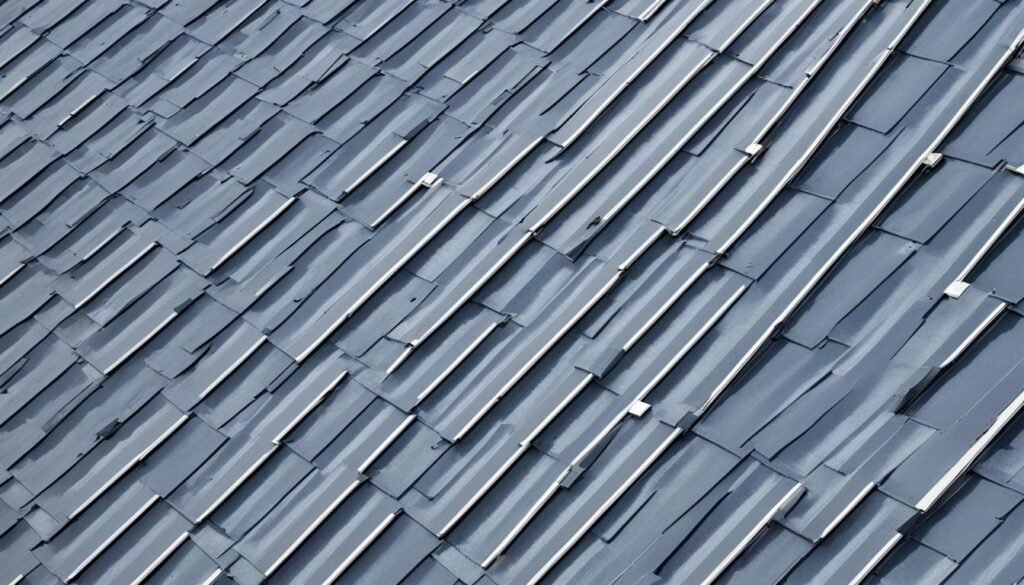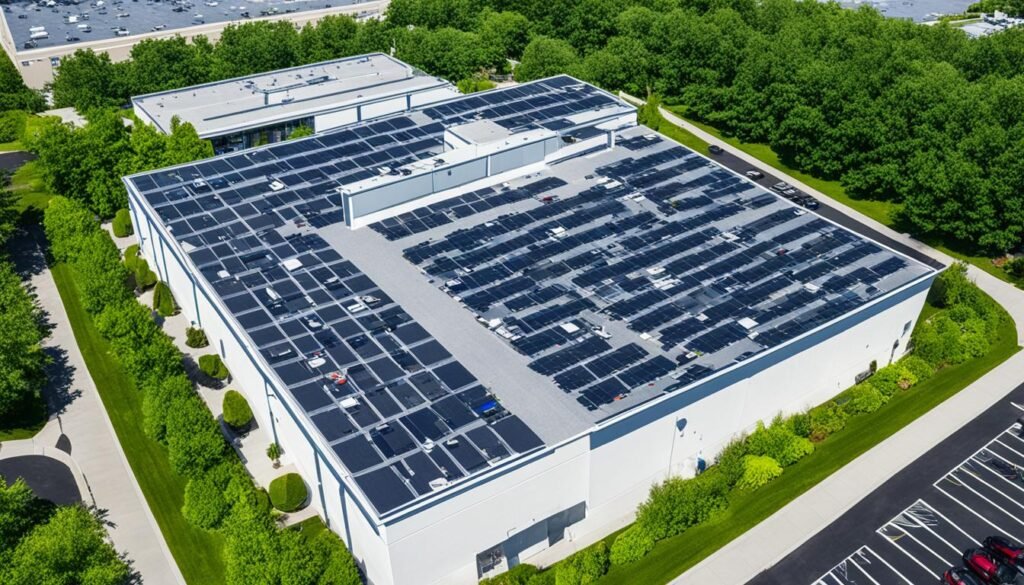Did you know that the average lifespan of a commercial roof is only 10 to 40 years? Considering the significant investment and importance of a commercial roof for your business, it’s essential to understand the factors that contribute to its lifespan and how to extend it.
- The average lifespan of a commercial roof is 10 to 40 years.
- Factors such as roofing material, installation process, weather conditions, and maintenance impact roof longevity.
- Regular maintenance can increase the life of a commercial roof by 30% to 100%.
- Proper maintenance includes inspections, cleaning, and repairs based on manufacturer guidelines.
- Investing in professional inspections and repairs can prevent costly repairs and replacements in the future.
Factors that Determine Lifespan of Commercial Roof Systems
When it comes to determining the lifespan of commercial roof systems, there are several factors at play. Understanding these factors can help building owners and managers make informed decisions to ensure the longevity and durability of their roofs.
One of the key factors influencing the lifespan of a commercial roof is the type of roofing material chosen. Different materials have varying levels of durability and longevity. For example, metal roofs are known for their exceptional durability and can last 40 to 70 years, while EPDM (Ethylene Propylene Diene Monomer) roofs have a lifespan of about 20 to 30 years. The choice of roofing material should align with the specific needs and requirements of the building to optimize longevity.
The installation process and the quality of materials used are also crucial factors in determining a commercial roof’s lifespan. Improper installation can lead to premature roof failure and reduced durability. It is essential to work with experienced and reputable roofing contractors who ensure proper installation techniques and use high-quality materials.
Weather conditions can significantly impact the durability of commercial roofs. Regions with frequent heavy storms or extreme temperatures may experience accelerated wear and tear. Proper insulation, effective drainage systems, and regular inspections can help mitigate the potential damage caused by severe weather conditions.
“Regular maintenance plays a crucial role in maintaining the longevity of a commercial roof and preventing issues that can shorten its lifespan.”
Regular maintenance is a key component of extending the lifespan of commercial roof systems. By adhering to a comprehensive maintenance program, building owners can identify and address issues early on, preventing them from becoming more significant problems. Regular inspections, cleaning, and repairs can help identify and mitigate potential risks, ultimately prolonging the roof’s lifespan.
Proper maintenance can increase the life of a commercial roof by 30% to 100%. – National Roofing Contractors Association (NRCA), American Institute of Plant Engineers Association for Facilities Engineers (AIPE/AFE)
By considering factors such as the type of roofing material, installation quality, weather conditions, and maintenance, commercial building owners can ensure the longevity and durability of their roofs. Taking proactive steps to protect and maintain the roof system can lead to significant cost savings in the long run, as well as minimize disruptions to business operations.
Lifespan of Common Commercial Roofing Materials
| Roofing Material | Average Lifespan |
|---|---|
| Metal Roofs | 40 to 70 years |
| EPDM (Ethylene Propylene Diene Monomer) Roofs | 20 to 30 years |
| Modified Bitumen Roofs | 20 to 30 years |
| TPO (Thermoplastic Olefin) Roofs | 15 to 30 years |
| PVC (Polyvinyl Chloride) Roofs | 20 to 30 years |

Extending Commercial Roof Lifespan: Maintenance Tips
To extend the lifespan of your commercial roof, proper maintenance is essential. According to the National Roofing Contractors Association (NRCA) and American Institute of Plant Engineers Association for Facilities Engineers (AIPE/AFE), routine maintenance can increase the life of a commercial roof by 30% to 100%.
Regular inspections, cleaning, and repairs should be conducted to identify and address any issues early on. By proactively monitoring the condition of your roof, you can prevent minor problems from escalating into major ones, saving you time and money in the long run.
When conducting inspections, pay close attention to potential weak points such as seams, flashing, and drainage systems. Properly sealed seams and well-maintained flashing can help prevent leaks and water damage. Clearing debris from gutters and ensuring proper drainage is also crucial for maintaining the integrity of your commercial roof.
Another important aspect of commercial roof maintenance is following the manufacturer’s guidelines and requirements. Different roofing materials may have unique maintenance needs, such as specific cleaning solutions or recommended repair methods. By adhering to these guidelines, you can ensure that your roof remains in optimal condition throughout its lifespan.
In addition to routine maintenance, it’s also essential to address any issues promptly. Ignoring small leaks or signs of damage can lead to more significant problems down the line. Consider hiring a professional roofing contractor to handle repairs and maintenance tasks to ensure the work is done correctly and to industry standards.

Regular Maintenance Checklist for Commercial Roofs
Here’s a checklist of essential maintenance tasks to help extend the lifespan of your commercial roof:
- Regularly inspect the roof for signs of damage, such as cracks, leaks, or loose materials.
- Clean and clear gutters and downspouts to ensure proper drainage.
- Trim nearby trees to prevent branches from damaging the roof.
- Check and secure flashing around vents, chimneys, and other penetration points.
- Remove debris, such as leaves or dirt, from the roof surface.
- Ensure that roof access points, such as hatches or skylights, are properly sealed and secure.
- Keep a record of maintenance activities and repairs.
- Consider scheduling professional inspections and maintenance at least once a year.
By implementing a proper maintenance program and addressing issues promptly, you can maximize the lifespan of your commercial roof, protecting your investment and ensuring the long-term durability of your building.
| Maintenance Task | Frequency |
|---|---|
| Inspections | At least once a year, or after severe weather events |
| Cleaning Gutters and Downspouts | Biannually or as needed |
| Trimming Trees | As needed |
| Checking and Securing Flashing | Annually or as needed |
| Removing Debris | Seasonally or as needed |
| Sealing Roof Access Points | Annually or as needed |
| Recordkeeping | Ongoing |
| Professional Inspections | At least once a year |
Conclusion
In summary, the lifespan of a commercial roof can vary depending on various factors such as the type of roofing material, installation process, weather conditions, and maintenance. Different types of roofing materials have different lifespans, ranging from 10 to 40 years. However, regardless of the material used, regular maintenance is crucial in extending the lifespan of a commercial roof.
By following proper maintenance guidelines and addressing any issues promptly, commercial building owners can ensure the longevity and durability of their roof. Regular inspections, cleaning, and repairs should be conducted to identify and address any potential problems early on. It is also important to adhere to the manufacturer’s maintenance guidelines and requirements.
Investing in professional inspections and repairs can help identify potential issues early, preventing costly repairs and replacements in the future. By implementing a comprehensive maintenance program, commercial building owners can protect their investment, avoid costly downtime and equipment damage, and extend the lifespan of their commercial roof.
For more information about commercial roof maintenance and tips on how to extend the lifespan of your commercial roof, please contact Local Roofer Pros at 951-666-5881 or visit https://roofingcontractorsmurrieta.com/.
FAQ
What factors determine the lifespan of a commercial roof?
Several factors influence the lifespan of commercial roof systems, including the type of roofing material used, the installation process, the quality of materials, and weather conditions.
What are some common types of commercial roofing materials and their lifespans?
Some common types of commercial roofing materials include EPDM, Modified bitumen, Metal roofs, TPO roofs, and PVC roofs. The lifespan of these materials can range from 10 to 40 years.
How can regular maintenance extend the lifespan of a commercial roof?
According to the National Roofing Contractors Association (NRCA) and American Institute of Plant Engineers Association for Facilities Engineers (AIPE/AFE), routine maintenance can increase the life of a commercial roof by 30% to 100%. Regular inspections, cleaning, and repairs should be conducted to identify and address any issues early on.
What are the benefits of following proper maintenance guidelines for a commercial roof?
Following proper maintenance guidelines can ensure the longevity and durability of a commercial roof. It can help prevent costly repairs and replacements in the future, protect the overall investment, and avoid downtime and equipment damage.
How can professional inspections and repairs contribute to extending the lifespan of a commercial roof?
Investing in professional inspections and repairs can help identify potential problems early on, preventing costly repairs and replacements in the future. Professionals have the expertise and knowledge to address any issues and ensure the roof is in good condition.
How can I learn more about commercial roof maintenance and extending the lifespan of my roof?
To learn more about commercial roof maintenance and extend the lifespan of your commercial roof, contact Local Roofer Pros at 951-666-5881 or visit https://roofingcontractorsmurrieta.com/.
